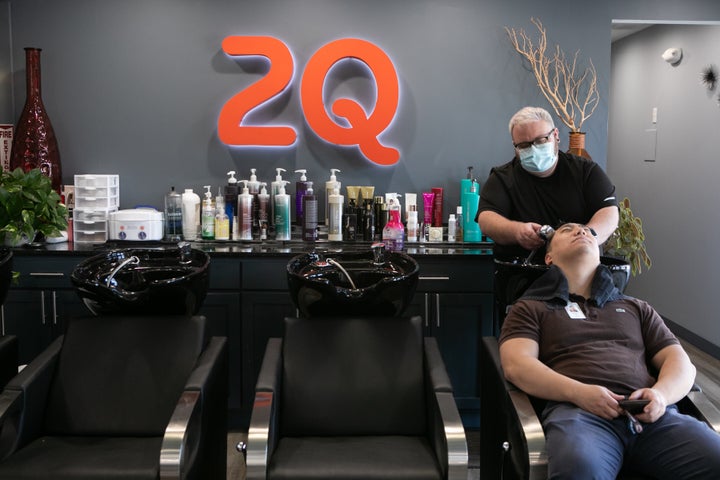The U.S. government’s response to the coronavirus pandemic was late and lethargic. As a result, the death toll here now tops 75,000, according to data compiled by Johns Hopkins University, even after weeks of stay-at-home orders, bans on public gatherings, and school and business closures.
That’s more dead Americans than the population of Portland, Maine, and more than double the U.S. lives lost during the Korean War. The U.S. leads all countries in both total reported fatalities and confirmed COVID-19 infections, which have now surpassed 1.25 million.
Unfortunately, there is no going back, no action that can make up for lost time. But if there’s a lesson to be learned from the last three months, it’s that what we do next will determine how many more Americans fall victim to COVID-19.
Thirty-one states have partially reopened their economies or announced plans to do so in the next week, according to a New York Times tracker. As stay-at-home orders and social distancing requirements are lifted, tens of thousands of lives are on the line.
The University of Washington’s Institute for Health Metrics and Evaluation, whose forecasts the White House cites most often, projected in late March that coronavirus-related deaths during the first wave of the U.S. outbreak could hit 90,000 by late summer. A little more than a week later, on April 7, the IHME’s projected death toll had dropped to around 60,000, based on the assumption that school closures and other social distancing measures in place across the nation would continue through May.
It wasn’t that earlier IHME forecasts had been wrong per se, but rather that newer data indicated Americans were hunkering down and that stay-at-home orders were working.
But once states started announcing plans to open back up, IHME began to raise its death toll estimate. On April 27, it increased its projection to 74,000 deaths by early August. And on Monday, the institute again revised its forecast upward to more than 134,000 deaths ― nearly double its previous estimate.
“It’s obvious from what we’ve seen over the epidemic so far that social distancing has made a huge impact,” Dr. Theo Vos, a professor and health data expert at the University of Washington, told HuffPost. “Without it, I think we would be seeing much stronger growth of cases.”
Dr. Anthony Fauci, director of the National Institute of Allergy and Infectious Diseases and a member of the White House’s coronavirus task force, warned as much in an April 9 interview on NBC’s “Today” show. “We better be careful that we don’t say, ‘OK, we’re doing so well we can pull back,’” he said. “We still have to put our foot on the accelerator when it comes to the mitigation and the physical separation.”
Timing And Testing Are Critical
The main reason for Monday’s sobering spike in the IHME model is that as states, with President Donald Trump’s encouragement, relax social distancing requirements and allow businesses to reopen, people are beginning to move around more, which is driving up disease transmission. Dr. Christopher Murray, chair of the University of Washington’s health metrics sciences department and director of IHME, told CNN that cellphone data shows people started increasing their activity even before states began lifting mandates and even in states that haven’t announced plans to do so.
Moving forward, two things will prove key to keeping the death toll down, Vos said.
“It’s the timing of relaxing restrictions and having the [testing] capacity to go into this containment phase of the epidemic, where you can be on top of new cases to such an extent that it doesn’t create new explosive growth and a surge in cases in hospitals, and subsequently a surge in deaths,” he said.
Trump, clearly worried about what the brutal pandemic could mean for his reelection bid, has shifted his focus away from mitigating the spread of the virus and toward reviving the American economy. He’s repeatedly stressed that the “cure can’t be worse than the problem itself,” praised himself for a job well done, tried to deflect blame toward China, insisted that the worst of the pandemic is behind us ― in many parts of the U.S., it’s not ― and made clear that he understands lifting stay-at-home orders at this stage will result in more death.
“The people of our country should think of themselves as warriors,” Trump said Tuesday before boarding Air Force One. “Our country has to open.”

Forecasting future deaths from COVID-19 is no easy task, as the many different and constantly shifting models indicate. Researchers at the University of Texas currently project between 78,000 and 92,000 deaths by the end of May. A Massachusetts Institute of Technology model pegs the figure at an estimated 111,000 for that same timeframe. And the Los Alamos National Laboratory forecasts 87,000 to 210,000 deaths by mid-June.
The latest IHME model predicts 111,000 deaths by the end of this month, with a possible range of 91,000 to 153,000 to account for uncertainty.
The decisions that state and federal officials make next will, in large part, determine how many more Americans get sick and die from COVID-19 this year. Trump and his Republican allies appear to have made the calculated decision that more people dying is the price that must be paid to get the economy moving again, even as health experts warn that many states have not met benchmarks that would allow them to safely ease restrictions.
“Of course, everybody wants to save every life they can ― but the question is, towards what end, ultimately?” former New Jersey Gov. Chris Christie, who led Trump’s transition team in 2016, told CNN this week. “There are going to be deaths no matter what,” Christie added. “We’ve got to let some of these folks get back to work, because if we don’t, we’re going to destroy the American way of life in these families. And it will be years and years before we can recover.”
Only nine states ― Alaska, Hawaii, Montana, North Dakota, Oregon, Tennessee, Utah, West Virginia and Wyoming ― are conducting enough COVID-19 tests to safely reopen by May 15, according to a new analysis by the Harvard Global Health Institute that NPR reported on Thursday.

Social Distancing Plummets
It is true that shutting down the economy has had huge negative social, financial and even health impacts. It is also true that reopening too soon will lead to otherwise avoidable deaths.
Researchers at Northeastern University predict there will be nearly 93,000 deaths in the U.S. from COVID-19 by May 28 if stay-at-home orders and mitigation policies remain in place through that date. With no mitigation, the death toll could top 1.7 million, their model found.
Despite the Trump administration’s rhetoric, the U.S. is far from out of the woods. An internal report by the Federal Emergency Management Agency, first obtained by The New York Times, found that the death toll could soar to 3,000 per day by June 1 ― a sharp increase over the current 1,750 deaths daily. Johns Hopkins University, which produced the analysis for FEMA, said in a media statement that the analysis was “preliminary” and not to be used for forecasting purposes.
Still, FEMA’s report confirms just how fragile the current situation is.
“The information illustrates that there are some scenarios, including the premature relaxation of social distancing, that are likely to cause significant increases in the number of COVID-19 cases and deaths in the United States,” said the Johns Hopkins statement.
Research by the University of Maryland shows that the extent to which people are following social distancing guidelines dropped 12% between April 23 and May 1, a period when more than a dozen states announced plans to begin partially reopening. Alabama, Georgia, Mississippi and Tennessee ― which have all eased restrictions or announced partial reopenings ― were among the states that tallied the biggest declines in their social distancing index scores.
“Our data suggests that the partial reopening orders have prompted a sharp drop in compliance with restrictions and guidelines,” professor Lei Zhang, the project leader for that research and director of the university’s Maryland Transportation Institute, said in a statement. “Although we were already seeing a gradual decline, the [social distancing index] has plummeted since these orders were announced.”
- Stay up to date with our live blog as we cover the COVID-19 pandemic
- What happens if we end social distancing too soon?
- What you need to know about face masks right now
- Will there be a second stimulus check?
- Lost your job due to coronavirus? Here’s what you need to know.
- Why it takes so long to make a coronavirus vaccine
- Parenting during the coronavirus crisis?
- The HuffPost guide to working from home
- What coronavirus questions are on your mind right now? We want to help you find answers.
- Everyone deserves accurate information about COVID-19. Support journalism without a paywall — and keep it free for everyone — by becoming a HuffPost member today.
